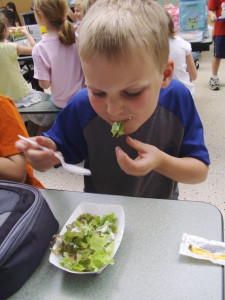
The Iowa City Community School District served fresh, locally grown lettuce to all students for the district’s Farm to School Chapter Spring Greens Day. A new online toolkit launched by the Iowa Valley RC&D will strengthen the Farm to School program. (photo/Cindy Hadish)
SOLON – Kelly Crossley knew something was going right when two of the three Solon District’s schools almost ran out of green peppers for lunch.
“They went over better than they normally do,” said Crossley, nutrition director for the district, noting that the peppers were purchased locally as part of the district’s new Farm to School chapter.
Crossley pointed to the taste as the reason behind the vegetable’s popularity and the local source as the defining factor for that flavorful difference.
Fresh tomatoes served on salads as the school year kicked off were equally in demand.
“They were wonderful,” Crossley said. “The level of quality between store-bought tomatoes and ones purchased locally is night and day.”
Students, teachers and staff will be tasting the difference periodically as Solon begins its first year in the Farm to School Program, coordinated by the Iowa Department of Agriculture and Land Stewardship, in partnership with the Iowa Department of Education.
The program links schools to farmers who provide fresh and minimally processed Iowa-grown food to include in meals and snacks.
This fall, the Iowa Valley RC&D is launching a new online toolkit to further develop those links.
The toolkit – at www.ialocalfoodforschools.org – will support area schools within the Iowa Valley region of Eastern Iowa by helping to implement Farm to School programs and purchasing food from local farms.
Other tools to connect schools and farms include food safety and preparation, purchasing rules and guidelines, a map of area schools and farms, as well as forms and templates.
Tammy Stotts, Farm to School Coordinator for the state, said the work undertaken by the RC&D is valuable in furthering the mission of the Farm to School program.
Farm to School encourages children to develop healthy eating habits and provides them with hands-on learning opportunities, such as farm visits, cooking demonstrations and school gardening programs.
Since 2008, more than $112,000 in grants have been allocated to 26 Farm to School chapters in Iowa, serving more than 69,000 kindergarten to 12th-grade students.
Stotts said another new chapter is starting this fall, bringing the total in Iowa to 27.
Funding is allocated through the U.S. Department of Agriculture, with up to $4,000 available per chapter.
“They each create their own plans” for the use of that money, she said.
Stotts noted that starting a chapter requires at least seven members, including one school administrator and one food service member, along with parents and others.
The program’s mission is to encourage the purchase of locally produced food by schools, strengthen the farm economy and offer educational opportunities to improve child nutrition and health.
“We don’t want it to be: buy food a couple of times and you’re done,” Stotts said. “We’re trying to create relationships.”
Those relationships can be difficult to form at times, which is one area where the new online toolkit will be beneficial.
Some school districts cite cost barriers as a factor in not purchasing locally.
Once districts embark on a Farm to School program, however, they find that the cost isn’t necessarily prohibitive, Stotts said.
In fact, both she and Crossley said that in-season produce purchased locally can be less expensive than other fruits and vegetables.
“Fresh tastes so much better and it doesn’t necessarily cost more when it’s in season,” Stotts said. “It’s a great opportunity for schools and the state in general, because it does reach so many people.”
Still, challenges remain in the availability of fresh produce and the duration of Iowa’s growing season, although that has been extended with the use of hoop houses to protect plants in the fall and allow them to start earlier in the spring.
That availability is another realm where the online toolkit can play a role in connecting growers to schools.
Twyla Hein, owner of Earth Biscuit Farm in rural Tipton, said she is selling to three school districts this year, providing cucumbers, peppers, tomatoes, sweet potatoes and zucchini in her first foray into Farm to School.
“You just need more,” Hein said of the difference in growing food for schools compared to other customers.
Jason Grimm, food system planner for Iowa Valley Resource Conservation and Development, linked Hein to the Iowa City School District, she said.
Stotts said making those connections can sometimes be a hurdle, adding that the work of the RC&D will help.
“Our biggest problem right now is finding enough growers,” she said, citing food that needs to be in high quantity as well as high quality, and delivered clean so processing is minimized.
Solon’s Crossley found a way to bring the school community together when 900 ears of locally purchased sweet corn had to be processed.
A call for volunteers on a Sunday brought out 32 people, including parents, teachers, students and food service employees who helped clean the corn.
“It was totally optional,” Crossley said. “I’m not going to force anyone to volunteer, but it really does take help from the community.”
FYI
Find more information on the new Iowa Valley RC&D online toolkit at www.ialocalfoodforschools.org

No Comments Yet